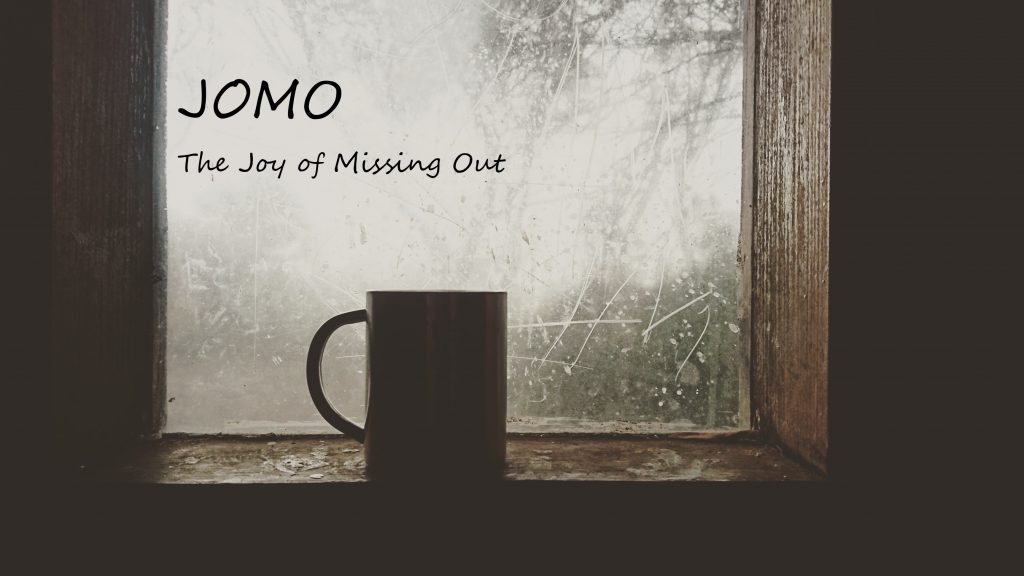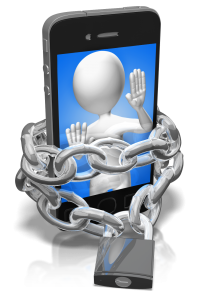Last week I learned a new word, compliments of Dictionary.com’s Word of the Day: JOMO, the Joy of Missing Out.

What is JOMO?
The definition is “a feeling of contentment with one’s own pursuits and activities, without worrying over the possibility of missing out on what others may be doing.” It’s the opposite of FOMO, Fear of Missing Out, often linked to negative emotions. Research conducted by the University of Copenhagen discovered that heavy Facebook users increased well-being by reducing the time spent on the site. Other studies have shown that Facebook can intensify depression among millennials.
Like most people, I spend a lot of time connected to digital devices. And I’m finding that the time spent is less fulfilling.
Now I’m not saying I’m ready to throw out my smartphone or disconnect from the Internet. (It’s clear I’m using technology now to write and disseminate this article.) But I am devoting more time outside, in nature. And I pay less attention to Facebook and other social media than in the past.
How the JOMO Movement Started
Christina Crook wrote the book, The Joy of Missing Out, in 2015. Before that, she went on a 31-day “digital detox.” She discussed it in a TEDx talk. And she’s continued to focus on the JOMO movement, launching a website earlier this year and a podcast series starting in June 2019.
About the same time, Crook was writing her book, technology entrepreneur Anil Dash used the term JOMO to describe his emotions after pulling away from technology when his son was born. (Anil Dash and Christina Crook are both credited by different people for having coined the term.) Since that time, the topic has surged in interest.
Recently the website PayScale argued that JOMO can help save your career. People who constantly check their phones may not realize the negative effect of multitasking on errors. “Research has found that the possibility of making a mistake on a task at work goes up after getting a phone call or text, 28 percent and 23 percent respectively.” In addition, practicing JOMO improves self-care. It allows you to control the constant bombardment of technology on your time and mental energy.
Taking Your Own JOMO Steps
Last year the New York Times published an article called, “How to Make This the Summer of Missing Out.” In it, Hayley Phelan said something that is rather profound. “Like it or not, we need our technology devices; we just don’t need them as much as we think we do. JOMO is about finding that balance.”
Phelan pointed out that even the tech industry is embracing the concept. Google has started its Digital Well-being project. Apple has added a “Do Not Disturb” function to its phones.
Of course, we need to take steps to progress toward JOMO. Phelan offered these five recommendations for controlling your tech addiction.

- Be prepared to acknowledge you have a problem. The tech industry has consciously designed products to be addictive, and we need to be aware of that.
- Manage your digital diet as much as you do the food you eat. Just as you are mindful of planning a well-balanced menu for your body, work to cultivate a well-balanced digital plan for your brain.
- Help people set realistic expectations for what they should expect from you. Don’t feel compelled to respond at once to all email and all texts all the time.
- Be intentional in your technology usage. If you don’t pay attention, the minutes you spend mindlessly surfing turn into hours and days.
- Think about technology accountability. Strive to use technology–rather than have it use you.
Final thoughts
I mentioned earlier it’s ironic that my blog post on JOMO uses the very technology I caution against. But I spent much of this week outside landscaping my yard. And when I finish this article, I will give myself a recess by reading a book (with actual paper!) that isn’t work-related.
The main point is maintaining balance. Use technology mindfully; never let it become your master. And replace FOMO with JOMO.
